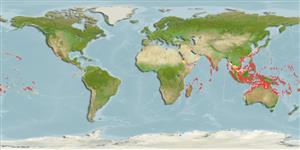Common names from other countries
Classification / Names / Names
Common names | Synonyms | Catalog of Fishes (gen., sp.) | ITIS | CoL | WoRMS
Environment: milieu / climate zone / depth range / distribution range
Ecology
Sessile; depth range 6 - 59 m (Ref. 102208). Tropical
Indo-Pacific.
Length at first maturity / Size / Weight / Age
Maturity: Lm ? range ? - ? cm
Maximum depth from Ref. 102316. Usually in large groups in approximately 1 m sand bottoms in flat bays and lagoons; fully exposed to solar radiation (Ref. 892). Filter-feeder (Ref. 68823).
Life cycle and mating behavior
Maturity | Reproduction | Spawning | Eggs | Fecundity | Larvae
Members of the class Demospongiae are hermaphroditic. Life cycle: The zygote develops into parenchymella larva (free-swimming) before settling down on a substrate where it grows into a young sponge.
Rützler, K. 1971. (Ref. 892)
IUCN Red List Status (Ref. 130435)
CITES status (Ref. 108899)
Not Evaluated
Not Evaluated
Threat to humans
Harmless
Human uses
| FishSource |
Tools
More information
Age/Size
Growth
Length-weight
Length-length
Morphology
Larvae
Abundance
Internet sources
Estimates based on models
Preferred temperature
(Ref.
115969): 26.5 - 29, mean 28.2 (based on 744 cells).
